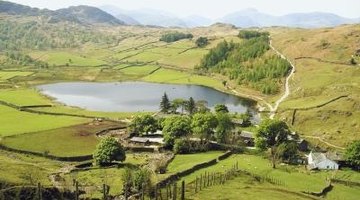How to Build a Dam Across a Gully to Form a Pond
Gully dams, or check dams, are a typical method for building farm ponds and accomplish two complementary objectives. First of all, they stop soil erosion. Additionally, after they fill, farm ponds can be used to water livestock, for fishing and even for swimming. Your pond must be large enough to accommodate the runoff that is eroding your gully. Ponds surrounded by bare dirt or steep slopes may quickly fill with sediment. But all ponds fill eventually, either by sedimentation or a process called eutrophication, in which nutrient-rich ponds eventually fill with weeds.

-
Note the use for your proposed pond. Fish ponds must be at least eight feet deep and have a surface area of at least 1/2 acre. Live-stock tanks can be much smaller.
-
Measure the shoreline for your pond. The shoreline must be entirely on your property. The watershed area you intend to drain should be about ten times the surface area of your pond.
-
Divert all runoff from feed lots, septic systems and barnyards from your watershed if you intend to use the pond for recreation, fishing or watering wildlife or livestock. If you cannot divert tainted runoff, you must find a new location for your pond.
-
Mark the proposed shoreline with wooden stakes.
-
Find the place in the gully you intend to dam. Gullies erode their way downstream, and the site of your dam should be near the end of the most-eroded portion of the gully.
-
Identify the content of the dirt around the gully and within your proposed pond. Sandy soil is unsuitable for dams. The more clay your soil contains, the better your dam will be.
-
Secure all necessary permits to excavate the pond, build the dam and harvest runoff. Some states, such as Florida, require permits, and some states, like Alabama, do not. Schedule all inspections and pay all fees required as part of the permit-issuing procedure if your state requires you to obtain a permit.
-
Excavate a bowl-shaped depression above your dam with a backhoe, and dump the excavated dirt in a "U" shape at the dam site. The bottom of the "U " should face your proposed pond.
-
Compact the excavated dirt at the dam site with hand tampers. Slope the downstream face of your dam at about a 30-degree angle.
-
Insert a six-inch-diameter overflow pipe through your dam level with your proposed shoreline. Water will flow through the pipe when the water in the pond rises above your proposed shoreline.
-
Incorporate a corrugated metal culvert into the downstream, sloped side of your dam under your overflow pipe. The culvert will prevent overflow from eroding the downstream side of your dam.
-
Remove all trees and brush from within 40 feet of your dam. Plant the top and downstream slope of your dam with grass. Depending on your watershed and the size of your pond, the new pond may take up to a year to fill.
References
Tips
- Fish often appear on their own in farm ponds. One explanation is that water birds may carry fish eggs on their feet.
- Fish in your pond will feed on mosquitoes.
Writer Bio
Don Davis has been a professional writer since 1977. He has had numerous writing jobs, including writing news and features for the "Metrowest Daily News" and "Los Angeles Herald-Examiner." Davis has a Bachelor of Arts in English and history from Indiana State University.
Photo Credits
- NA/AbleStock.com/Getty Images
More Articles



